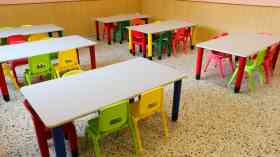
How schools can generate income
Scott Warrington, who set up School Letting Solutions (SLS) with his business partner Paul Andrews five years ago, explains how schools can generate their own income by opening their doors to the community
School and academy leaders are currently faced with a juggling act of complex issues. Whether it’s from increasingly squeezed budgets, higher demand for school places or growing concerns about young people’s mental health, schools are still expected to balance these while providing a high-quality education and a positive springboard into adolescence and adulthood.
Having started my career in community development in schools, I’ve experienced many of these challenges first-hand, but have also witnessed some great examples of schools taking a proactive and efficient approach to responding to some of these challenges. These are the institutions that have spotted the silver linings and are making the most of them for the benefit of their pupils and the wider community.
Here I’ll discuss why I think it’s so important for schools to consider generating their own income through letting out their facilities and the wider benefits this can have for the organisation, young people and the whole community.
Opening doors to great community spaces
My business partner Paul Andrews and I had fifteen years’ experience managing community development in schools when we first started exploring the idea of setting up our own business. The idea for SLS came as a direct result of our on the ground experience managing school facilities. We understood the unique way in which academic organisations work and how to provide a service which would meet their needs.
We quickly realised that the vast majority of school halls, pitches, classrooms and theatres were lying empty and unused on evenings and weekends, while at the same time grassroots sports and community groups were crying out for affordable, accessible venues to host their activities.
Minimum effort, maximum gain
We estimate from experience that well over half of school facilities are currently shut on evenings and weekends. These great facilities are effectively being wasted and schools are missing out on an opportunity to create a new income stream. I’ve even worked with schools that were running at a deficit and have turned this around by letting out their facilities to local groups and positioning themselves as an active part of the local community.
Working with a partner to fully manage facilities means schools don’t have to worry about administration, out of hours staffing or managing the financials. They can concentrate on their core academic purpose, with the reassurance that their facilities are not lying dormant on evenings and weekends and that they are proactively generating income which can be invested back into the organisation for the benefit of its pupils. It’s a win-win situation for everyone.
Benefitting pupils and the wider community
But in such pressurised times, why should schools be thinking about renting their facilities? Just taking the example of sport and exercise, our research found that amongst those who didn’t select ‘none of these’, more than a fifth (22% per cent) of British adults with children in their household say they would take their children to sports and community groups if they took place at their school. And striking research from Sport England showed that underachieving young people who take part in sport see a 29 per cent increase in numeracy skills and a 12-16 per cent rise in other transferable skills.
Schools are perfectly placed to make a real difference to encouraging involvement in sport, both as part of the curriculum and outside school hours. One of many success stories is the fact that one of our partner school’s sports pitches are now used every weekend by hundreds of people aged seven and upwards playing for a local football team. Previously, players were having to travel several miles to grounds outside the area and the pitches were lying dormant out of school hours.
Schools have an opportunity to think even bigger, though. By opening their doors to wider communities they can support, not only their students, but local people of all generations who can reap the benefits. The same Sport England study revealed that unemployed people who take part in sports are 11 per cent more likely than non-participants to have looked for a job in the last four weeks.
Much more than sport
When thinking about how local people can benefit from school facilities, sport is just one part of this. The hirers we work with at SLS range from choirs that support older people with health conditions such as dementia to roller skating dance groups. Organisations like Arts Council England highlight that participation in arts can contribute to community cohesion, reduce social exclusion and isolation and make communities feel safer and stronger.
And thinking about young people in particular, students from low income families who take part in arts activities at school are three times more likely to get a degree than children in low income families who do not engage in arts activities at school. Another compelling reason why schools should be thinking about the difference they can make outside school hours.
Food for thought
By opening their doors outside school hours, schools have a huge opportunity to not only get better financial security, but to make a tangible impact to their pupils and the wider community.
Schools, colleges and academies are arguably perfectly placed to act as neighbourhood leisure facilities. There are thousands more schools than there are leisure centres in the UK, therefore hundreds of thousands more people could have the chance to take part in affordable, fun community and sports groups.
While it gives schools a chance to offer more opportunities to their students that have positive benefits to health, wellbeing and academic attainment, it also opens up opportunities for all. Amongst those respondents who didn’t select ‘none of these’, over a quarter* (27 per cent) of British adults with children in their household admitted that their children actively take part in activities such as sport, but they themselves do not.
Perhaps if they took place in the same local venue, busy parents would get the chance to pursue a sport or hobby too. And if people don’t have the funds or mobility to access public transport to travel to the nearest leisure centre, imagine if they could socialise with other people in their community or learn a new skill at the school over the road?
From where I’m standing, the benefits really do outweigh any concerns, so I’d encourage all school and academy leaders to consider making this small step to making a big difference.
Authored by Scott Warrington
Further Information:Latest News
19/12/2025 - 09:54
The Education Committee has expanded its ongoing inquiry into the early years sector to examine how safeguarding can be strengthened in early years settings.
18/12/2025 - 09:25
The UK will be rejoining the Erasmus programme in 2027, following a package of agreements with the EU.
17/12/2025 - 09:31
Ofqual has fined exam board Pearson more than £2 million in total for serious breaches in three separate cases between 2019 and 2023 which collectively affected tens of thousands of students.
16/12/2025 - 09:19
The average funding rates will increase by 4.3% for under 2s, and by almost 5% for 3-and-4-year-olds.
15/12/2025 - 10:30
Local colleges are set to receive £570 million in government funding to expand training facilities in areas such as construction and engineering.







